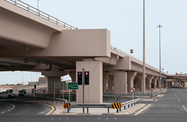A possible merger between the Kingdom’s two airlines, combined with increasing hotel occupancy rates and a rise in traffic at the Bahrain International Airport, are proving promising for the aviation industry’s expansion.
The recent restructuring of one of the region’s oldest airlines, Gulf Air, Bahrain’s government-owned flag carrier, has created overlap with the evolving business plan of the Kingdom’s second carrier, Bahrain Air, which launched as a privately owned low-cost carrier in early 2008 but now offers both economy and business-class cabins.
Earlier this year, Richard Nuttall, Bahrain Air’s CEO, told Arabian Business that his airline was open to a potential tie-up with Gulf Air.
“We are very open to merging with Gulf Air and can see a number of synergies,” he said. “It’s no secret that Gulf Air, Bahrain Air and most airlines in the region are hurting. If we come together we can rationalise and be that much more efficient with less cost.”
Gulf Air’s management was initially non-committal about a possible deal with its smaller rival, but Bloomberg recently cited the Arabic daily Al Watan as saying that Gulf Air’s CEO, Samer Majali, had suggested a merger was possible as Bahrain could not sustain two separate airlines.
Combining resources and services could prove beneficial to serving a growing local tourism market. A survey carried out earlier this year by STR Global, which studies the global hotel industry, found Manama enjoyed a 69.5% increase in hotel occupancy rates in April, the biggest single jump across Africa and the Middle East.
A further indicator that tourists and business travellers are returning to Bahrain in greater numbers was provided when Bahrain International Airport registered a 12% rise in traffic over the first five months of the year, according to local media. The airport served 3.35m passengers as opposed to 2.99m over the same period last year.
But the airlines are not just pinning growth on expansion at home: the two carriers are currently rival bidders for a licence to operate domestic flights across the border in Saudi Arabia. Competition is fierce and Qatar Airways and China’s Hainan Airlines are among the other bidders. Last year almost 7m people used Saudi Arabia’s domestic airports alone, marking a 13.7% increase on 2010, while 54m used both domestic and international facilities. A final decision is expected in October.
But while local headlines regularly focus on commercial deals, route expansions and profit gains, Gulf Air has found positive news stories harder to come by.
The carrier had struggled for several years before seeing a return to profitability in June and July. Under Majali, the airline has attempted to streamline staff numbers and has increasingly targeted more regional, short-haul markets.
But the Arab spring and the civil unrest that has followed in Bahrain over the past 18 months have naturally impacted Gulf Air’s performance. The Mumtalakat Holding Company, the Bahraini government’s sovereign wealth fund which owns the airline, saw its consolidated full-year losses widen last year to more than $700m and the flag carrier’s difficulties were highlighted as a significant factor in a recent company statement.
The airline has persevered with its emphasis on well-frequented regional routes, upping services to Dubai, Amman and Beirut, as well as shelving less popular longer-haul routes such as Milan, Athens and Kuala Lumpur. Gulf Air also achieved cost savings of $67.6m last year, and it is hoping to see a further 15% reduction in its cost base this year. The airline has also recently resumed flights to Iraq and Iran.
Gulf Air does face competition at home from Bahrain Air. Since launching, Bahrain Air has faced the challenge of the 2009 global turndown, the impact of the domestic and wider regional political upheaval, as well as expensive fuel costs due to spikes in the oil price. The company has yet to post a full-year profit and last year it saw its revenues fall 30% and its fleet reduced from six to four leased aircraft.
But the airline has seen tangible progress in 2012. The carrier enjoyed a 67% increase in revenue during June and July, when compared to the same period last year (the airline did not reveal specific figures), in addition to a 27% rise in load factors.
It is clear that in a turbulent economy, Bahrain’s aviation segment is looking at all possible options to growth, including a merger and a bid abroad. Whether or not the possible merger does go through, a successful bid for a licence in Saudi Arabia would provide the airline concerned with a new set of challenges but, equally, a major opportunity in the region’s biggest economy.

